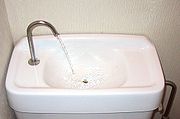Nice article about fuel efficiency in the Washington Post
Tuesday, May 27, 2008
There was an article just a few hours ago in the Washington Post about the Prius and how some of its owners compete with each other for higher fuel efficiency in various ways, such as trying to avoid hills, learning how to brake and accelerate without using too much fuel, and so on. This is a nice example of how people, when given proper information, are able to take matters into their own hands in reducing fuel usage.
In the Prius and other hybrids with energy displays, drivers can see what specific actions mean for their mileage. In some ways, it is like children learning to color in between the lines, with the teacher standing over their shoulders. Aggressive acceleration after a stoplight -- that's bad. The monitor will show mpg going down. Suddenly slamming the brakes -- also bad. Coasting to a stop -- good. That tactic lets the engine shut down, saving gas. Hills -- oh, they are real bad.
Tom Igoe, a physical-computing researcher at New York University, said the Prius mpg display is one of the best examples of technology "where green meets information systems."
"For a long time," he said, "we have known that people will change their habits if they are exposed to feedback in real time."
and:
Instead of being content with the 48 miles per gallon in the city and 45 miles per gallon on the highway -- 2008 EPA standards for the Prius -- some drivers try to find ways to get far more and go to extremes to do so. When Lee Peterson's wife wanted to borrow his Prius, he barked "No." His wife was baffled. He said: "You're gonna screw up my mileage."
Peterson, an Ohio retail consultant and former Jeep driver, had never been interested in mileage. But when he got a Prius, he became fixated with stretching his mileage as far as possible. Peterson keeps track of his mileage the way golfers chart their handicaps. His record back when his wife wanted the car was 57.4 miles to the gallon. But the monitor put him at 58 -- more than double the 27.5 mpg that non-hybrid passenger cars are required to get in the United States. He had a quarter-tank to go.
"I was going to break my record," Peterson said, but only if his wife steered clear of his wheels.
Peterson now tries to avoid a big hill on his way to work. "If I go up the hill, it really puts stress on the car," he said. "That's when you start to do the weird Prius thing. I'm looking at the display, and I'm getting 10 to 15 miles to the gallon."
He didn't think about the hill when he drove his Jeep. "It's just knowledge," he said. "Now I have it. Knowledge is king."
I'm a big fan of small, well-distributed solutions to problems like this. In Japan for example toilets have a handle that can be pushed both ways - turn it to one side and it gives you a full flush like a standard toilet in most other places, but turn it to the other side and it'll only change the water for as long as you hold it down. That means if you don't have to feel bad anymore about wasting tons of water for a quick #1 as you head out the door. At the same time, there's a sink on the top of the toilet where the water comes back in; instead of refilling the back out of sight, it first flows through a faucet in the top (because the water is perfectly clean), and then into a hole which fills it up again. So you don't have to use any water to wash your hands either. The water is cold of course, so for shaving you still have to use the other sink. See, here's what it looks like:
It's the 'people starving in China' argument you hear when you're young. Finish your food, because there are people starving in China. My response was always that if I could use my food to help people starving there I'd gladly give it to them, but that was impossible. In most cases if you give people the information and the ability to make a difference, they'll do it.







0 comments:
Post a Comment